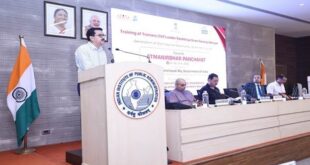Why in NEWS
The stage is set for a high-profile clash between the Opposition and the Treasury benches, as Lok Sabha Speaker on Wednesday admitted a no-confidence motion against the Modi government, which was moved by the Congress’s Deputy Leader in the House in a bid to force the Prime Minister to speak in Parliament on the Manipur conflict.
No-Confidence motion:
A no-confidence motion is a procedure in a parliamentary system whereby an elected official or a body of elected officials can be removed from office by a vote of no confidence.
*In India, a no-confidence motion can be moved only in the Lok Sabha (the lower house of the Parliament of India) and after at least 50 members of Parliament support it, the Speaker may grant a leave and after considering the state of business in the House.
The motion is then debated in the Lok Sabha, and if it is passed by a majority of the members present and voting, the government must resign.
No Confidence motion in past
There have been 15 no-confidence motions moved in the Lok Sabha since independence, but only one has been successful. In 1989, the government of Rajiv Gandhi was defeated by a no-confidence motion moved by the Janata Dal and the Left Front.
The most recent no-confidence motion was moved in 2018 against the government of Narendra Modi. The motion was defeated by a vote of 325-126.
The procedure for moving a no-confidence motion in India is as follows:
- A member of the Lok Sabha must submit a written notice of the motion to the Speaker.
- The motion must be supported by at least 50 members of the Lok Sabha.
- The Speaker then decides whether to admit the motion for discussion.
- If the motion is admitted, the Speaker decides on the date and time for the discussion.
- The motion is then debated in the Lok Sabha.
- If the motion is passed by a majority of the members present and voting, the government must resign.
A no-confidence motion is a powerful tool that can be used to remove an unpopular government from power. However, it is also a risky move, as it can backfire and strengthen the government’s position if it is defeated.
Different types of motions in the Parliament
There are different types of motions that can be moved in Parliament, each with its own purpose. Some of the most common types of motions include:
Adjournment motion: This type of motion is used to request that the House be adjourned for a specified period of time. Adjournment motions are typically moved to discuss a matter of urgent public importance.
No-confidence motion: This type of motion is used to express the House’s lack of confidence in the government. If a no-confidence motion is passed, the government must resign.
Motion of thanks: This type of motion is moved at the end of a parliamentary session to express the House’s thanks to the President or Governor for their address to the House.
Cut motion: This type of motion is used to shorten the debate on a particular matter. Cut motions are typically moved by the government to prevent the opposition from filibustering.
Privilege motion: This type of motion is used to protect the rights of members of Parliament. Privilege motions can be moved to challenge the Speaker’s ruling, to protect a member from arrest, or to demand an apology from a government minister.
 Chinmaya IAS Academy – Current Affairs Chinmaya IAS Academy – Current Affairs
Chinmaya IAS Academy – Current Affairs Chinmaya IAS Academy – Current Affairs



